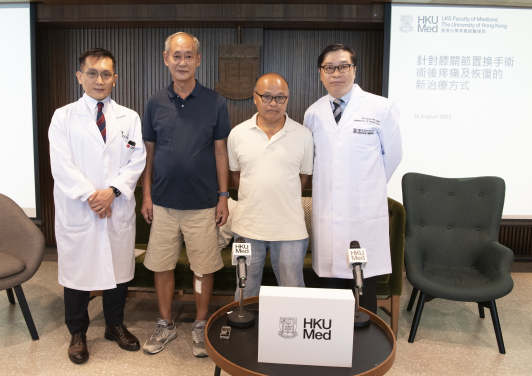Media
HKUMed endeavoured to optimise TKA patients’ postoperative pain relief and functional recovery through a clinical trial
30 Aug 2023
A research team from Department of Orthopaedics and Traumatology, and Department of Anaesthesiology, School of Clinical Medicine, LKS Faculty of Medicine of the University of Hong Kong (HKUMed), have evaluated whether a combination of intravenous corticosteroids (IVS) and periarticular corticosteroids (PAS) could provide new insights into pain management and postoperative rehabilitation following total knee arthroplasty. The findings were published in the Journal of Bone and Joint Surgery [link to the publication].
Background
3,981 total joint replacement operations were done in public hospitals from 1 July 2022 to 30 June 2023. Total knee arthroplasty (TKA) is a cost-effective treatment for severe knee osteoarthritis and which is a widely performed procedure. Many patients experience substantial postoperative pain despite multimodal analgesia. Previous studies have reported effective pain relief and improved mobilization after TKA with either IVS or PAS administration. However, no research on pain relief and functional recovery by using a combination of both IVS and PAS (IVSPAS) could be found.
Research methods and findings
In a randomized clinical trial (RCT) conducted between April 2018 and January 2022, 178 patients undergoing initial TKA were randomly assigned to receive IVS, PAS, or IVSPAS, and the fourth group received inactive placebo injections. Pain relief and key rehabilitation parameters were compared across groups. The research confirms the role of IVS in pain management after TKA, with significant reductions in pain scores and morphine use. Yet, PAS yielded non-significant reductions in pain scores but patients’ walking distances were significantly improved. PAS facilitates physical function by reducing inflammatory mediators both locally and systemically, thus decreasing local knee swelling. As for the combined administration of IVS plus PAS, it produced a similar analgesic effect as IVS and further provided greater functional recovery, with immediate effect after surgery.
IVSPAS led to improvement in several physical measures during rehabilitation. Observed for three consecutive days, the flexion of the operated knee could perform better in patients who received IVSPAS (average range of flexion in knee joint is 93.6 ± 7.5 degrees) compared with the placebo (average range of flexion in knee joint is 87.8 ± 9.8 degrees) on the third post-surgery day. The IVSPAS group also had greater quadriceps muscle strength, walked farther and obtained higher scores on the Elderly Mobility Scale, an assessment tool on locomotion, balance and key position changes. With IVSPAS, patients were more likely to be discharged back home from the hospital (67% compared with 38% in the placebo group), rather than to a rehabilitation facility. Rates of discharge back home were 55% with IVS and 59% with PAS respectively.
Significance of the study
By this RCT, the research team concluded that IVS and IVSPAS were indirectly shown to provide better pain relief than PAS. Although patients with IVSPAS had pain relief similar to those with IVS, the combined administration of corticosteroids yielded more significant improvements in the rehabilitation parameters. ‘This study provides new insights into pain management in TKA that may enable better functional recovery and rehabilitation, and the novel treatment with its cost-effectiveness may serve as a stepping stone in turning arthroplasty into an outpatient procedure,’ said Dr Lewis Chan Ping-keung, Clinical Associate Professor, Department of Orthopaedics and Traumatology, School of Clinical Medicine, HKUMed.
About the research team
The research was led by Dr Lewis Chan Ping-keung, Clinical Associate Professor, Department of Orthopaedics and Traumatology, School of Clinical Medicine, HKUMed, Honorary Consultant, Division Chief, Division of Joint Replacement Surgery, Department of Orthopaedics & Traumatology, Queen Mary Hospital, Co-director, Joint Replacement Centre, Gleneagles Hospital Hong Kong and Dr Timmy Chan Chi-wing, Honorary Clinical Associate Professor, Department of Anaesthesiology, School of Clinical Medicine, HKUMed, Consultant, Clinical Team Head of Pain Management Team, Department of Anaesthesia, Pain and Perioperative Medicine, Queen Mary Hospital. Members of research team are Dr Henry Mak Chi-yeung, Dr Manson Chan Tak-hei and Dr Will Chan Shing-him, Associate Consultants, Department of Anaesthesia, Pain and Perioperative Medicine, Queen Mary Hospital; Dr Stanley Wong Sau-ching, Clinical Associate Professor and Interim Chairperson; and Professor Cheung Chi-wai, Clinical Professor, Department of Anaesthesiology, School of Clinical Medicine, HKUMed; Dr Henry Fu Chun-him, Clinical Assistant Professor; Dr Vincent Chan Wai-kwan, Honorary Assistant Professor; Dr Steve Cheung Man-hong, Clinical Assistant Professor; and Professor Peter Chiu Kwong-yuen, Honorary Clinical Professor, Department of Orthopaedics and Traumatology, School of Clinical Medicine, HKUMed; Dr Amy Cheung Yim-ling, Associate Consultant, Department of Orthopaedics and Traumatology, Queen Mary Hospital.
Media enquiries
Please contact LKS Faculty of Medicine of The University of Hong Kong by email (medmedia@hku.hk).

